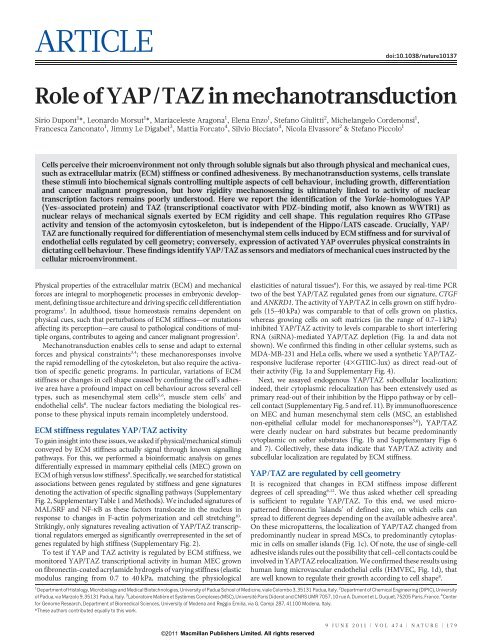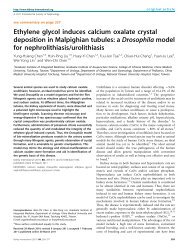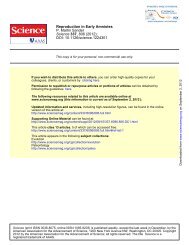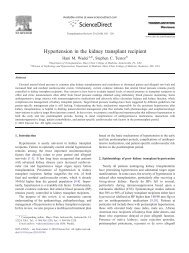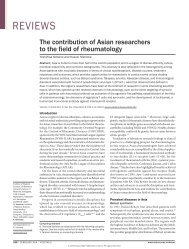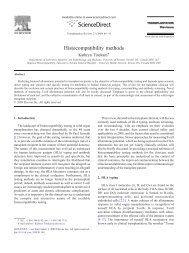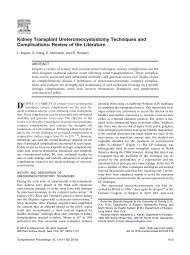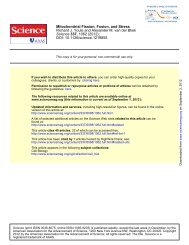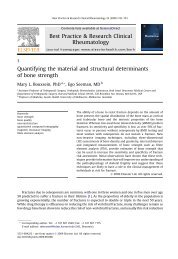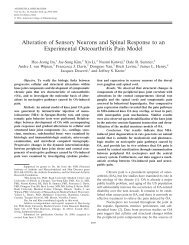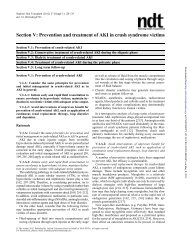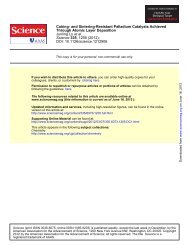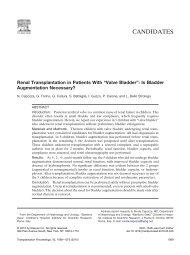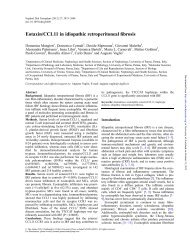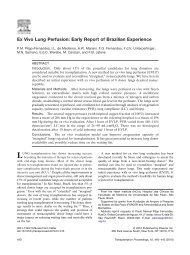Role of YAP/TAZ in mechanotransduction
Role of YAP/TAZ in mechanotransduction
Role of YAP/TAZ in mechanotransduction
You also want an ePaper? Increase the reach of your titles
YUMPU automatically turns print PDFs into web optimized ePapers that Google loves.
ARTICLE doi:10.1038/nature10137<br />
<strong>Role</strong> <strong>of</strong> <strong>YAP</strong>/<strong>TAZ</strong> <strong>in</strong> <strong>mechanotransduction</strong><br />
Sirio Dupont 1 *, Leonardo Morsut 1 *, Mariaceleste Aragona 1 , Elena Enzo 1 , Stefano Giulitti 2 , Michelangelo Cordenonsi 1 ,<br />
Francesca Zanconato 1 , Jimmy Le Digabel 3 , Mattia Forcato 4 , Silvio Bicciato 4 , Nicola Elvassore 2 & Stefano Piccolo 1<br />
Cells perceive their microenvironment not only through soluble signals but also through physical and mechanical cues,<br />
such as extracellular matrix (ECM) stiffness or conf<strong>in</strong>ed adhesiveness. By <strong>mechanotransduction</strong> systems, cells translate<br />
these stimuli <strong>in</strong>to biochemical signals controll<strong>in</strong>g multiple aspects <strong>of</strong> cell behaviour, <strong>in</strong>clud<strong>in</strong>g growth, differentiation<br />
and cancer malignant progression, but how rigidity mechanosens<strong>in</strong>g is ultimately l<strong>in</strong>ked to activity <strong>of</strong> nuclear<br />
transcription factors rema<strong>in</strong>s poorly understood. Here we report the identification <strong>of</strong> the Yorkie-homologues <strong>YAP</strong><br />
(Yes-associated prote<strong>in</strong>) and <strong>TAZ</strong> (transcriptional coactivator with PDZ-b<strong>in</strong>d<strong>in</strong>g motif, also known as WWTR1) as<br />
nuclear relays <strong>of</strong> mechanical signals exerted by ECM rigidity and cell shape. This regulation requires Rho GTPase<br />
activity and tension <strong>of</strong> the actomyos<strong>in</strong> cytoskeleton, but is <strong>in</strong>dependent <strong>of</strong> the Hippo/LATS cascade. Crucially, <strong>YAP</strong>/<br />
<strong>TAZ</strong> are functionally required for differentiation <strong>of</strong> mesenchymal stem cells <strong>in</strong>duced by ECM stiffness and for survival <strong>of</strong><br />
endothelial cells regulated by cell geometry; conversely, expression <strong>of</strong> activated <strong>YAP</strong> overrules physical constra<strong>in</strong>ts <strong>in</strong><br />
dictat<strong>in</strong>g cell behaviour. These f<strong>in</strong>d<strong>in</strong>gs identify <strong>YAP</strong>/<strong>TAZ</strong> as sensors and mediators <strong>of</strong> mechanical cues <strong>in</strong>structed by the<br />
cellular microenvironment.<br />
Physical properties <strong>of</strong> the extracellular matrix (ECM) and mechanical<br />
forces are <strong>in</strong>tegral to morphogenetic processes <strong>in</strong> embryonic development,<br />
def<strong>in</strong><strong>in</strong>g tissue architecture and driv<strong>in</strong>g specific cell differentiation<br />
programs 1 . In adulthood, tissue homeostasis rema<strong>in</strong>s dependent on<br />
physical cues, such that perturbations <strong>of</strong> ECM stiffness—or mutations<br />
affect<strong>in</strong>g its perception—are causal to pathological conditions <strong>of</strong> multiple<br />
organs, contributes to age<strong>in</strong>g and cancer malignant progression 2 .<br />
Mechanotransduction enables cells to sense and adapt to external<br />
forces and physical constra<strong>in</strong>ts 3,4 ; these mechanoresponses <strong>in</strong>volve<br />
the rapid remodell<strong>in</strong>g <strong>of</strong> the cytoskeleton, but also require the activation<br />
<strong>of</strong> specific genetic programs. In particular, variations <strong>of</strong> ECM<br />
stiffness or changes <strong>in</strong> cell shape caused by conf<strong>in</strong><strong>in</strong>g the cell’s adhesive<br />
area have a pr<strong>of</strong>ound impact on cell behaviour across several cell<br />
types, such as mesenchymal stem cells 5,6 , muscle stem cells 7 and<br />
endothelial cells 8 . The nuclear factors mediat<strong>in</strong>g the biological response<br />
to these physical <strong>in</strong>puts rema<strong>in</strong> <strong>in</strong>completely understood.<br />
ECM stiffness regulates <strong>YAP</strong>/<strong>TAZ</strong> activity<br />
To ga<strong>in</strong> <strong>in</strong>sight <strong>in</strong>to these issues, we asked if physical/mechanical stimuli<br />
conveyed by ECM stiffness actually signal through known signall<strong>in</strong>g<br />
pathways. For this, we performed a bio<strong>in</strong>formatic analysis on genes<br />
differentially expressed <strong>in</strong> mammary epithelial cells (MEC) grown on<br />
ECM <strong>of</strong> high versus low stiffness 9 . Specifically, we searched for statistical<br />
associations between genes regulated by stiffness and gene signatures<br />
denot<strong>in</strong>g the activation <strong>of</strong> specific signall<strong>in</strong>g pathways (Supplementary<br />
Fig. 2, Supplementary Table 1 and Methods). We <strong>in</strong>cluded signatures <strong>of</strong><br />
MAL/SRF and NF-kB as these factors translocate <strong>in</strong> the nucleus <strong>in</strong><br />
response to changes <strong>in</strong> F-act<strong>in</strong> polymerization and cell stretch<strong>in</strong>g 10 .<br />
Strik<strong>in</strong>gly, only signatures reveal<strong>in</strong>g activation <strong>of</strong> <strong>YAP</strong>/<strong>TAZ</strong> transcriptional<br />
regulators emerged as significantly overrepresented <strong>in</strong> the set <strong>of</strong><br />
genes regulated by high stiffness (Supplementary Fig. 2).<br />
To test if <strong>YAP</strong> and <strong>TAZ</strong> activity is regulated by ECM stiffness, we<br />
monitored <strong>YAP</strong>/<strong>TAZ</strong> transcriptional activity <strong>in</strong> human MEC grown<br />
on fibronect<strong>in</strong>-coated acrylamide hydrogels <strong>of</strong> vary<strong>in</strong>g stiffness (elastic<br />
modulus rang<strong>in</strong>g from 0.7 to 40 kPa, match<strong>in</strong>g the physiological<br />
elasticities <strong>of</strong> natural tissues 6 ). For this, we assayed by real-time PCR<br />
two <strong>of</strong> the best <strong>YAP</strong>/<strong>TAZ</strong> regulated genes from our signature, CTGF<br />
and ANKRD1. The activity <strong>of</strong> <strong>YAP</strong>/<strong>TAZ</strong> <strong>in</strong> cells grown on stiff hydrogels<br />
(15–40 kPa) was comparable to that <strong>of</strong> cells grown on plastics,<br />
whereas grow<strong>in</strong>g cells on s<strong>of</strong>t matrices (<strong>in</strong> the range <strong>of</strong> 0.7–1 kPa)<br />
<strong>in</strong>hibited <strong>YAP</strong>/<strong>TAZ</strong> activity to levels comparable to short <strong>in</strong>terfer<strong>in</strong>g<br />
RNA (siRNA)-mediated <strong>YAP</strong>/<strong>TAZ</strong> depletion (Fig. 1a and data not<br />
shown). We confirmed this f<strong>in</strong>d<strong>in</strong>g <strong>in</strong> other cellular systems, such as<br />
MDA-MB-231 and HeLa cells, where we used a synthetic <strong>YAP</strong>/<strong>TAZ</strong>responsive<br />
luciferase reporter (43GTIIC-lux) as direct read-out <strong>of</strong><br />
their activity (Fig. 1a and Supplementary Fig. 4).<br />
Next, we assayed endogenous <strong>YAP</strong>/<strong>TAZ</strong> subcellular localization;<br />
<strong>in</strong>deed, their cytoplasmic relocalization has been extensively used as<br />
primary read-out <strong>of</strong> their <strong>in</strong>hibition by the Hippo pathway or by cell–<br />
cell contact (Supplementary Fig. 5 and ref. 11). By immun<strong>of</strong>luorescence<br />
on MEC and human mesenchymal stem cells (MSC, an established<br />
non-epithelial cellular model for mechanoresponses 5,6 ), <strong>YAP</strong>/<strong>TAZ</strong><br />
were clearly nuclear on hard substrates but became predom<strong>in</strong>antly<br />
cytoplasmic on s<strong>of</strong>ter substrates (Fig. 1b and Supplementary Figs 6<br />
and 7). Collectively, these data <strong>in</strong>dicate that <strong>YAP</strong>/<strong>TAZ</strong> activity and<br />
subcellular localization are regulated by ECM stiffness.<br />
<strong>YAP</strong>/<strong>TAZ</strong> are regulated by cell geometry<br />
It is recognized that changes <strong>in</strong> ECM stiffness impose different<br />
degrees <strong>of</strong> cell spread<strong>in</strong>g 6,12 . We thus asked whether cell spread<strong>in</strong>g<br />
is sufficient to regulate <strong>YAP</strong>/<strong>TAZ</strong>. To this end, we used micropatterned<br />
fibronect<strong>in</strong> ‘islands’ <strong>of</strong> def<strong>in</strong>ed size, on which cells can<br />
spread to different degrees depend<strong>in</strong>g on the available adhesive area 8 .<br />
On these micropatterns, the localization <strong>of</strong> <strong>YAP</strong>/<strong>TAZ</strong> changed from<br />
predom<strong>in</strong>antly nuclear <strong>in</strong> spread MSCs, to predom<strong>in</strong>antly cytoplasmic<br />
<strong>in</strong> cells on smaller islands (Fig. 1c). Of note, the use <strong>of</strong> s<strong>in</strong>gle-cell<br />
adhesive islands rules out the possibility that cell–cell contacts could be<br />
<strong>in</strong>volved <strong>in</strong> <strong>YAP</strong>/<strong>TAZ</strong> relocalization. We confirmed these results us<strong>in</strong>g<br />
human lung microvascular endothelial cells (HMVEC, Fig. 1d), that<br />
are well known to regulate their growth accord<strong>in</strong>g to cell shape 8 .<br />
1 2<br />
Department <strong>of</strong> Histology, Microbiology and Medical Biotechnologies, University <strong>of</strong> Padua School <strong>of</strong> Medic<strong>in</strong>e, viale Colombo 3, 35131 Padua, Italy. Department <strong>of</strong> Chemical Eng<strong>in</strong>eer<strong>in</strong>g (DIPIC), University<br />
<strong>of</strong> Padua, via Marzolo 9, 35131 Padua, Italy.<br />
*These authors contributed equally to this work.<br />
3 Laboratoire Matière et Systèmes Complexes (MSC), Université Paris Diderot and CNRS UMR 7057, 10 rue A. Dumont et L. Duquet, 75205 Paris, France. 4 Center<br />
for Genome Research, Department <strong>of</strong> Biomedical Sciences, University <strong>of</strong> Modena and Reggio Emilia, via G. Campi 287, 41100 Modena, Italy.<br />
©2011<br />
Macmillan Publishers Limited. All rights reserved<br />
9 JUNE 2011 | VOL 474 | NATURE | 179
a<br />
mRNA expression<br />
c<br />
d<br />
RESEARCH ARTICLE<br />
<strong>YAP</strong>/<strong>TAZ</strong><br />
<strong>YAP</strong>/<strong>TAZ</strong><br />
100<br />
50<br />
0<br />
CTGF ANKRD1 4xGTIIC-lux<br />
90<br />
si<br />
Co.<br />
Unpatt.<br />
si<br />
YZ1<br />
si<br />
YZ2<br />
10,000 300 μm 2<br />
** ** **<br />
40<br />
kPa<br />
0.7<br />
kPa<br />
Micropillars<br />
60<br />
30<br />
0<br />
Cells seeded on stiff hydrogels or large islands show <strong>in</strong>creased cell<br />
spread<strong>in</strong>g but, at the same time, experience a broader cell–ECM contact<br />
area. To test whether <strong>YAP</strong>/<strong>TAZ</strong> are regulated by cell spread<strong>in</strong>g<br />
irrespectively <strong>of</strong> the total amount <strong>of</strong> ECM, we visualized <strong>YAP</strong>/<strong>TAZ</strong><br />
localization <strong>in</strong> MSC grown on the tip <strong>of</strong> closely arrayed fibronect<strong>in</strong>coated<br />
micropillars 12 : on these arrays, cells stretch from one micropillar<br />
to another, and assume a projected cell area comparable to cells<br />
plated on big islands (3,200 mm 2 on average, Fig. 1e); however, <strong>in</strong> these<br />
conditions, the actual area available for cell–ECM <strong>in</strong>teraction is only<br />
about 10% <strong>of</strong> their projected area (300 mm 2 on average, correspond<strong>in</strong>g<br />
to the smallest islands used <strong>in</strong> Fig. 1c). <strong>YAP</strong>/<strong>TAZ</strong> rema<strong>in</strong>ed nuclear on<br />
micropillars (Fig. 1e), <strong>in</strong>dicat<strong>in</strong>g that <strong>YAP</strong>/<strong>TAZ</strong> are primarily regulated<br />
by cell spread<strong>in</strong>g imposed by the ECM.<br />
<strong>YAP</strong>/<strong>TAZ</strong> sense cytoskeletal tension<br />
We then considered that cell spread<strong>in</strong>g entails activation <strong>of</strong> the small<br />
GTPase Rho that, <strong>in</strong> turn, regulates the formation <strong>of</strong> act<strong>in</strong> bundles,<br />
stress fibres and tensile actomyos<strong>in</strong> structures 2,3 . Indeed, cells on stiff<br />
ECM or big islands had more prom<strong>in</strong>ent stress fibres compared to<br />
Luciferase activity<br />
10,000 2,025 1,024 300 μm 2<br />
e<br />
<strong>YAP</strong>/<strong>TAZ</strong><br />
b<br />
<strong>YAP</strong>/<strong>TAZ</strong><br />
TOTO3<br />
Cell area<br />
(μm 2 )<br />
ECM area<br />
(μm 2 )<br />
Nuclear<br />
40 kPa 0.7 kPa <strong>YAP</strong>/<strong>TAZ</strong> (%)<br />
100<br />
50<br />
0<br />
40 0.7<br />
100<br />
75<br />
50<br />
25<br />
0<br />
6,000<br />
3,000 0<br />
6,000<br />
3,000<br />
0<br />
Nuclear 100<br />
500<br />
<strong>YAP</strong>/<strong>TAZ</strong> (%)<br />
Nuclear <strong>YAP</strong>/<strong>TAZ</strong> (%)<br />
Unpatt.<br />
10,000<br />
2,025<br />
1,024<br />
300<br />
300 μm2 Unpatt.<br />
Micropillars<br />
Figure 1 | <strong>YAP</strong>/<strong>TAZ</strong> are regulated by ECM stiffness and cell shape a, Realtime<br />
PCR analysis <strong>in</strong> MCF10A cells (CTGF and ANKRD1, coloured bars) and<br />
luciferase reporter assay <strong>in</strong> MDA-MB-231 cells (43GTIIC-lux, black bars) to<br />
measure <strong>YAP</strong>/<strong>TAZ</strong> transcriptional activity. Cells were transfected with the<br />
<strong>in</strong>dicated siRNAs (siCo., control siRNA; siYZ1 and siYZ2, two <strong>YAP</strong>/<strong>TAZ</strong><br />
siRNAs; see Supplementary Fig. 3) and grown on plastic, or plated on stiff<br />
(elastic modulus <strong>of</strong> 40 kPa) and s<strong>of</strong>t (0.7 kPa) fibronect<strong>in</strong>-coated hydrogels.<br />
Data are normalized to lane 1. n 5 4. b, Confocal immun<strong>of</strong>luorescence images<br />
<strong>of</strong> <strong>YAP</strong>/<strong>TAZ</strong> and nuclei (TOTO3) <strong>in</strong> human mesenchymal stem cells (MSC)<br />
plated on hydrogels. Scale bars, 15 mm. Graphs <strong>in</strong>dicate the percentage <strong>of</strong> cells<br />
with nuclear <strong>YAP</strong>/<strong>TAZ</strong>. (n 5 3). c, On top: grey patterns show the relative size<br />
<strong>of</strong> micropr<strong>in</strong>ted fibronect<strong>in</strong> islands on which cells were plated. Outl<strong>in</strong>e <strong>of</strong> a cell<br />
is shown superimposed to the leftmost unpatterned area (Unpatt.). Below:<br />
confocal immun<strong>of</strong>luorescence images <strong>of</strong> MSC plated on fibronect<strong>in</strong> islands <strong>of</strong><br />
decreas<strong>in</strong>g sizes (mm 2 ). Scale bars, 15 mm. Graph provides quantifications.<br />
(n 5 8). See also Supplementary Fig. 8. d, Confocal immun<strong>of</strong>luorescence<br />
images <strong>of</strong> <strong>YAP</strong>/<strong>TAZ</strong> <strong>in</strong> HMVEC plated as <strong>in</strong> c. Scale bars, 15 mm. See also<br />
Supplementary Fig. 9. e, On top: grey dots exemplify the distribution <strong>of</strong><br />
fibronect<strong>in</strong> on micropillar arrays, shown superimposed with the outl<strong>in</strong>e <strong>of</strong> a<br />
cell. Below: representative immun<strong>of</strong>luorescence <strong>of</strong> <strong>YAP</strong>/<strong>TAZ</strong> <strong>in</strong> MSC plated on<br />
rigid micropillars. Scale bars, 15 mm. Graphs, quantification <strong>of</strong> the projected cell<br />
area, total ECM contact area, and nuclear <strong>YAP</strong>/<strong>TAZ</strong> <strong>in</strong> MSC plated on<br />
unpatterned fibronect<strong>in</strong>, micropillars and 300 mm 2 islands. (n 5 4). All error<br />
bars are s.d. (*P , 0.05; **P , 0.01; Student’s t-test is used throughout).<br />
Experiments were repeated n times with duplicate biological replicates.<br />
**<br />
those plated on s<strong>of</strong>t ECM or small islands (Supplementary Figs 9 and<br />
10). As shown <strong>in</strong> Fig. 2a, we found that Rho and the act<strong>in</strong> cytoskeleton<br />
are required to ma<strong>in</strong>ta<strong>in</strong> nuclear <strong>YAP</strong>/<strong>TAZ</strong> <strong>in</strong> MSC. As a control,<br />
<strong>in</strong>hibition <strong>of</strong> Rac1-GEFs (guan<strong>in</strong>e nucleotide exchange factors), or<br />
disruption <strong>of</strong> microtubules, did not alter <strong>YAP</strong>/<strong>TAZ</strong> localization<br />
(Fig. 2a). Similar results were obta<strong>in</strong>ed also <strong>in</strong> HMVEC and MEC<br />
(not shown). Crucially, <strong>in</strong>hibition <strong>of</strong> Rho and <strong>of</strong> the act<strong>in</strong> cytoskeleton<br />
also <strong>in</strong>hibited <strong>YAP</strong>/<strong>TAZ</strong> transcriptional activity, as assayed by<br />
expression <strong>of</strong> endogenous target genes (Fig. 2b) and by luciferase<br />
reporter assays (Fig. 2c). Conversely, trigger<strong>in</strong>g F-act<strong>in</strong> polymerization<br />
and stress fibres formation by overexpression <strong>of</strong> activated diaphanous<br />
prote<strong>in</strong> (DIAPH1) promoted <strong>YAP</strong>/<strong>TAZ</strong> activity (Supplementary Fig.<br />
12).<br />
We then asked whether <strong>YAP</strong>/<strong>TAZ</strong> are regulated by the ratio <strong>of</strong><br />
monomeric/filamentous act<strong>in</strong>, as others observed for MAL/SRF 13 .<br />
To <strong>in</strong>crease monomeric G-act<strong>in</strong>, we overexpressed the R62D mutant<br />
act<strong>in</strong> 13 , but this was <strong>in</strong>sufficient to <strong>in</strong>hibit <strong>YAP</strong>/<strong>TAZ</strong> (Fig. 2c).<br />
Moreover, <strong>in</strong>creas<strong>in</strong>g the amount <strong>of</strong> F-act<strong>in</strong> either by overexpress<strong>in</strong>g<br />
the F-act<strong>in</strong> stabiliz<strong>in</strong>g V159N act<strong>in</strong> mutant or by serum stimulation 13<br />
had no effect on <strong>YAP</strong>/<strong>TAZ</strong> activity (Supplementary Fig. 13) or nuclear<br />
localization (data not shown). As a control, <strong>in</strong> the same experimental<br />
set-up, MAL/SRF activity was <strong>in</strong>stead clearly modulated<br />
a Control C3 Lat.A<br />
b<br />
<strong>YAP</strong>/<strong>TAZ</strong><br />
c<br />
Luciferase activity<br />
NSC23766<br />
Noco<br />
4xGTIIC-lux<br />
125<br />
100<br />
75<br />
50<br />
25<br />
0<br />
e<br />
Luciferase activity<br />
Co.<br />
Lat.A<br />
4xGTIIC-lux<br />
Co.<br />
Y27632<br />
Blebbist.<br />
Act<strong>in</strong> R62D<br />
180 | NATURE | VOL 474 | 9 JUNE 2011<br />
©2011<br />
Macmillan Publishers Limited. All rights reserved<br />
<strong>YAP</strong>/<strong>TAZ</strong><br />
40<br />
30<br />
20<br />
10<br />
0<br />
d<br />
<strong>YAP</strong>/<strong>TAZ</strong><br />
f<br />
<strong>YAP</strong>/<strong>TAZ</strong><br />
Nuclear <strong>YAP</strong>/<strong>TAZ</strong> (%)<br />
Control<br />
100<br />
75<br />
50<br />
25<br />
0<br />
Rigid<br />
pillars<br />
Co.<br />
C3<br />
Lat.A<br />
NSC<br />
Noco.<br />
Elastic<br />
pillars<br />
Nuclear<br />
<strong>YAP</strong>/<strong>TAZ</strong> (%)<br />
mRNA expression<br />
Y27632 Blebbist.<br />
100<br />
80<br />
60<br />
40<br />
20 0<br />
Nuclear<br />
<strong>YAP</strong>/<strong>TAZ</strong> (%)<br />
100<br />
50<br />
0<br />
Co.<br />
100<br />
50<br />
0<br />
Rigid<br />
Elastic<br />
CTGF<br />
ANKRD1<br />
**<br />
**<br />
C3<br />
Lat.A<br />
Co.<br />
Y27632<br />
Blebbist.<br />
Figure 2 | <strong>YAP</strong>/<strong>TAZ</strong> activity requires Rho and tension <strong>of</strong> the act<strong>in</strong><br />
cytoskeleton a, Confocal immun<strong>of</strong>luorescence images <strong>of</strong> <strong>YAP</strong>/<strong>TAZ</strong> <strong>in</strong> MSC<br />
treated with the Rho <strong>in</strong>hibitor C3 (3 mgml 21 ), the F-act<strong>in</strong> <strong>in</strong>hibitor latruncul<strong>in</strong><br />
A (Lat.A, 0.5 mM), the Rac1-GEFs <strong>in</strong>hibitor NSC23766 (100 mM) or the<br />
microtubule <strong>in</strong>hibitor nocodazole (Noco., 30 mM). Scale bars, 15 mm. Graph<br />
provides quantifications (n 5 10). See also Supplementary Fig. 11. b, Real-time<br />
PCR <strong>of</strong> MCF10A treated with cytoskeletal <strong>in</strong>hibitors as <strong>in</strong> a. Data are<br />
normalized to untreated cells (Co.) (n 5 4). c, Luciferase assay for <strong>YAP</strong>/<strong>TAZ</strong><br />
activity <strong>in</strong> HeLa cells transfected with the <strong>in</strong>dicated expression plasmids (Co. is<br />
empty vector, act<strong>in</strong> R62D encodes for a mutant unable to polymerize <strong>in</strong>to<br />
F-act<strong>in</strong>) and treated with latruncul<strong>in</strong> A (n 5 4). Similar effects were observed <strong>in</strong><br />
MDA-MB-231 (not shown). d, Confocal immun<strong>of</strong>luorescence images <strong>of</strong> MSC<br />
treated with the ROCK <strong>in</strong>hibitor Y27632 (50 mM), or the non-muscle myos<strong>in</strong><br />
<strong>in</strong>hibitor blebbistat<strong>in</strong> (Blebbist., 50 mM). Scale bars, 15 mm. Graph provides<br />
quantifications (n 5 9). See also Supplementary Fig. 15. e, Luciferase activity <strong>of</strong><br />
the <strong>YAP</strong>/<strong>TAZ</strong> reporter <strong>in</strong> HeLa treated as <strong>in</strong> d. (n 5 4). f, Confocal<br />
immun<strong>of</strong>luorescence images <strong>of</strong> MSC plated on arrays <strong>of</strong> micropillars <strong>of</strong><br />
different rigidities. On rigid micropillars (black l<strong>in</strong>es) cells develop cytoskeletal<br />
tension (blue arrow) by pull<strong>in</strong>g aga<strong>in</strong>st the ECM (orange arrow); cells bend<br />
elastic micropillars and develop reduced tension exemplified by reduced size <strong>of</strong><br />
the arrows. Scale bars, 15 mm. Graph provides quantifications (n 5 2). See also<br />
Supplementary Fig. 19. All error bars are s.d. (*P , 0.05; **P , 0.01).<br />
Experiments were repeated n times with duplicate biological replicates.
(Supplementary Fig. 14). Taken altogether, these data <strong>in</strong>dicate that<br />
Rho and stress fibres, but not F-act<strong>in</strong> polymerization per se, are<br />
required for <strong>YAP</strong>/<strong>TAZ</strong> activity.<br />
Cells respond to the rigidity <strong>of</strong> the ECM by adjust<strong>in</strong>g the tension<br />
and organization <strong>of</strong> their stress fibres, such that cell spread<strong>in</strong>g is<br />
accompanied by <strong>in</strong>creased pull<strong>in</strong>g forces aga<strong>in</strong>st the ECM 3,6,12 .By<br />
<strong>in</strong>hibition <strong>of</strong> ROCK and non-muscle myos<strong>in</strong> 4,6 , we found that cytoskeletal<br />
tension is required for <strong>YAP</strong>/<strong>TAZ</strong> nuclear localization (Fig. 2d)<br />
and activity (Fig. 2e and Supplementary Fig. 16). Of note, <strong>YAP</strong>/<strong>TAZ</strong><br />
exclusion caused by these <strong>in</strong>hibitions is an early event (occurr<strong>in</strong>g<br />
with<strong>in</strong> 2 h) that can be uncoupled from destabilization <strong>of</strong> stress fibres<br />
(see Supplementary Fig. 17). By comparison, the activity <strong>of</strong> MAL/SRF<br />
was only marg<strong>in</strong>ally affected by the same treatments (Supplementary<br />
Fig. 18). To address more directly the relevance <strong>of</strong> cell-generated<br />
mechanical force without us<strong>in</strong>g small-molecule <strong>in</strong>hibitors and irrespectively<br />
<strong>of</strong> the surface properties <strong>of</strong> the hydrogels, we compared<br />
rigid versus highly elastic micropillars 12 ; on the elastic substrate, cytoplasmic<br />
localization <strong>of</strong> <strong>YAP</strong>/<strong>TAZ</strong> was clearly <strong>in</strong>creased (Fig. 2f).<br />
Collectively, the data <strong>in</strong>dicate that <strong>YAP</strong>/<strong>TAZ</strong> respond to cytoskeletal<br />
tension.<br />
We also tested if <strong>in</strong>hibition <strong>of</strong> <strong>YAP</strong>/<strong>TAZ</strong> occurs by entrapp<strong>in</strong>g<br />
<strong>YAP</strong>/<strong>TAZ</strong> <strong>in</strong> the cytoplasm or by promot<strong>in</strong>g their nuclear exclusion.<br />
As shown <strong>in</strong> Supplementary Fig. 20a, blockade <strong>of</strong> nuclear export with<br />
leptomyc<strong>in</strong> B rescued nuclear localization <strong>of</strong> <strong>YAP</strong>/<strong>TAZ</strong> <strong>in</strong> MSC<br />
treated with cytoskeletal <strong>in</strong>hibitors, <strong>in</strong>dicat<strong>in</strong>g that <strong>YAP</strong>/<strong>TAZ</strong> keeps<br />
shuttl<strong>in</strong>g between cytoplasm and nucleus irrespectively <strong>of</strong> cell tension,<br />
and that the presence <strong>of</strong> a tense cytoskeleton promotes their nuclear<br />
retention. Moreover, <strong>YAP</strong>/<strong>TAZ</strong> relocalization was rapid (occurr<strong>in</strong>g <strong>in</strong><br />
as little as 30 m<strong>in</strong> with latruncul<strong>in</strong> A), reversible after small-molecule<br />
washout (Supplementary Fig. 20b), and <strong>in</strong>sensitive to <strong>in</strong>hibition <strong>of</strong><br />
prote<strong>in</strong> synthesis with cycloheximide (data not shown), suggest<strong>in</strong>g a<br />
direct biochemical mechanism.<br />
Mechanical cues act <strong>in</strong>dependently from Hippo<br />
<strong>YAP</strong> and <strong>TAZ</strong> are the nuclear transducers <strong>of</strong> the Hippo pathway 14 .In<br />
several organisms and cellular set-ups, activation <strong>of</strong> the Hippo pathway<br />
leads to <strong>YAP</strong>/<strong>TAZ</strong> phosphorylation on specific ser<strong>in</strong>e residues; <strong>in</strong><br />
turn, these phosphorylations <strong>in</strong>hibit <strong>YAP</strong>/<strong>TAZ</strong> activity through multiple<br />
mechanisms, <strong>in</strong>clud<strong>in</strong>g proteasomal degradation 14 . Intrigu<strong>in</strong>gly,<br />
similar to Hippo activation by cell–cell contacts (Fig. 3a), <strong>TAZ</strong> prote<strong>in</strong><br />
was also degraded by grow<strong>in</strong>g MEC on s<strong>of</strong>t matrices (Fig. 3b) or by<br />
treatment with <strong>in</strong>hibitors <strong>of</strong> Rho, F-act<strong>in</strong> and actomyos<strong>in</strong> tension<br />
(Fig. 3c and Supplementary Fig. 21). Similar results were obta<strong>in</strong>ed<br />
with MSC and HMVEC (Supplementary Fig. 22 and data not shown).<br />
Is then the Hippo cascade responsible for <strong>YAP</strong>/<strong>TAZ</strong> <strong>in</strong>hibition by<br />
mechanical cues? Several evidences <strong>in</strong>dicate this is not the case. First,<br />
we noted that phosphorylation <strong>of</strong> <strong>YAP</strong> on ser<strong>in</strong>e 127, a key target <strong>of</strong><br />
the LATS k<strong>in</strong>ase downstream <strong>of</strong> the Hippo pathway 15 , was not<br />
<strong>in</strong>creased upon treatment <strong>of</strong> MEC and MSC with cytoskeletal <strong>in</strong>hibitors<br />
(Fig. 3c and Supplementary Fig. 22), at difference with its regulation<br />
by high confluence (see Fig. 3a). Second, depletion <strong>of</strong> LATS1<br />
and LATS2 (see Fig. 3f and Supplementary Fig. 23 for positive controls)<br />
had marg<strong>in</strong>al effect on <strong>YAP</strong>/<strong>TAZ</strong> <strong>in</strong>activation by mechanical<br />
cues, as judged by (1) <strong>YAP</strong>/<strong>TAZ</strong> nuclear exit <strong>in</strong>duced by micropatterns<br />
or cytoskeletal <strong>in</strong>hibition <strong>in</strong> MEC, MSC or HMVEC (Fig. 3d and<br />
Supplementary Figs 24, 25 and data not shown); (2) <strong>TAZ</strong> degradation<br />
(Fig. 3e); (3) endogenous target gene expression <strong>in</strong> cells plated on s<strong>of</strong>t<br />
hydrogels (Fig. 3f) or treated with latruncul<strong>in</strong> A (Supplementary Fig.<br />
26). F<strong>in</strong>ally, we compared wild-type or LATS-<strong>in</strong>sensitive 4SA 16 <strong>TAZ</strong><br />
<strong>in</strong> MDA-MB-231 depleted <strong>of</strong> endogenous <strong>YAP</strong>/<strong>TAZ</strong> and reconstituted<br />
at near-to-endogenous <strong>YAP</strong>/<strong>TAZ</strong> activity levels with siRNA<strong>in</strong>sensitive<br />
mouse <strong>TAZ</strong> vectors. As shown <strong>in</strong> Fig. 3g, both wild-type<br />
and 4SA <strong>TAZ</strong> rema<strong>in</strong> sensitive to mechanical cues. Further support<strong>in</strong>g<br />
these results, we found that MDA-MB-231 cells are homozygous<br />
mutant for NF2 (also known as merl<strong>in</strong>, Supplementary Fig. 27), an<br />
essential component <strong>of</strong> the Hippo cascade 14 . Collectively, these data<br />
a<br />
b<br />
Sparse<br />
Dense<br />
<strong>TAZ</strong><br />
GAPDH<br />
P-S127<br />
<strong>YAP</strong><br />
40 0.7 kPa<br />
<strong>TAZ</strong><br />
GAPDH<br />
c d<br />
Co.<br />
C3<br />
Lat.A<br />
<strong>TAZ</strong><br />
GAPDH<br />
P-S127<br />
<strong>YAP</strong><br />
LATS1<br />
MST2<br />
mRNA expression<br />
si control siLATS A<br />
Adhesive island area (μm 2 )<br />
<strong>in</strong>dicate that LATS phosphorylation downstream <strong>of</strong> the Hippo cascade<br />
is not the primary mediator <strong>of</strong> mechanical/physical cues <strong>in</strong> regulat<strong>in</strong>g<br />
<strong>YAP</strong>/<strong>TAZ</strong> activity.<br />
We then asked if mechanical cues regulate <strong>YAP</strong>/<strong>TAZ</strong> not only <strong>in</strong><br />
isolated cells, but also <strong>in</strong> confluent monolayers, when cells reorganize<br />
their shape and structure and engage <strong>in</strong> cell–cell contacts, lead<strong>in</strong>g to<br />
activation <strong>of</strong> Hippo/LATS signall<strong>in</strong>g 11 . We first explored the effects <strong>of</strong><br />
cell confluence <strong>in</strong> a simplified experimental set-up, namely <strong>in</strong> MCF10A<br />
cells rendered <strong>in</strong>sensitive to Hippo activation by depletion <strong>of</strong> LATS1/2;<br />
<strong>in</strong> these conditions, Rho and the cytoskeleton rema<strong>in</strong> relevant <strong>in</strong>puts to<br />
support <strong>TAZ</strong> stability (Supplementary Fig. 28). Moreover, <strong>in</strong> parental<br />
MCF10A, plat<strong>in</strong>g cells at high confluence cooperate with s<strong>of</strong>t hydrogels<br />
<strong>in</strong> <strong>in</strong>hibit<strong>in</strong>g <strong>YAP</strong>/<strong>TAZ</strong> activity (Fig. 3h). Thus, mechanical cues and<br />
Hippo signall<strong>in</strong>g represent two parallel <strong>in</strong>puts converg<strong>in</strong>g on <strong>YAP</strong>/<br />
<strong>TAZ</strong> regulation.<br />
<strong>YAP</strong>/<strong>TAZ</strong> mediate cellular mechanoresponses<br />
Data presented so far <strong>in</strong>dicate <strong>YAP</strong> and <strong>TAZ</strong> as molecular ‘readers’ <strong>of</strong><br />
ECM elasticity and cell geometry, but are <strong>YAP</strong>/<strong>TAZ</strong> relevant to mediate<br />
the biological responses to these mechanical <strong>in</strong>puts? An appropriate<br />
Nuclear <strong>YAP</strong>/<strong>TAZ</strong> (%)<br />
100<br />
80<br />
60<br />
40<br />
20<br />
0<br />
10,000<br />
2,025<br />
1,024<br />
300<br />
10,000<br />
2,025<br />
1,024<br />
300<br />
e C3 C3<br />
– low high<br />
Co. L Co. L Co. L siRNA<br />
f CTGF ANKRD1<br />
8 ** **<br />
6<br />
<strong>TAZ</strong><br />
4<br />
Lam<strong>in</strong>B<br />
2<br />
0<br />
** ** **<br />
kPa 40 0.7 40 0.7 40 0.7<br />
g<br />
4xGTIIC-lux<br />
80 –<br />
siControl siLATS A siLATS B<br />
h CTGF ANKRD1<br />
60<br />
40<br />
20<br />
+ Lat.A<br />
0.7 KPa<br />
100<br />
80<br />
60<br />
40<br />
**<br />
*<br />
0<br />
20<br />
+WT<br />
m<strong>TAZ</strong><br />
+4SA<br />
m<strong>TAZ</strong><br />
0<br />
kPa 40 0.7 40 0.7<br />
siControl si<strong>YAP</strong>/<strong>TAZ</strong><br />
Sparse Dense<br />
Luciferase activity<br />
©2011<br />
Macmillan Publishers Limited. All rights reserved<br />
Figure 3 | ECM stiffness and cell spread<strong>in</strong>g regulate <strong>YAP</strong>/<strong>TAZ</strong><br />
<strong>in</strong>dependently <strong>of</strong> the Hippo pathway a–c, Immunoblott<strong>in</strong>g for the <strong>in</strong>dicated<br />
prote<strong>in</strong>s <strong>in</strong> MCF10A under the follow<strong>in</strong>g conditions: a, plat<strong>in</strong>g on plastic at low<br />
(sparse) or high (dense) confluence; b, plat<strong>in</strong>g on stiff (40 kPa) or s<strong>of</strong>t (0.7 kPa)<br />
hydrogels; c, untreated (Co.) or treated with C3 and latruncul<strong>in</strong> A (Lat.A).<br />
P-S127 is phospho-<strong>YAP</strong>. d, Quantification <strong>of</strong> nuclear <strong>YAP</strong>/<strong>TAZ</strong> <strong>in</strong> MSC<br />
transfected with control or LATS1/2 siRNA A (siLATS A) and plated on<br />
micropr<strong>in</strong>ted islands <strong>of</strong> different size (n 5 4). Similar results were obta<strong>in</strong>ed<br />
with HMVEC (not shown). e, Immunoblott<strong>in</strong>g from MSC cells transfected<br />
with the <strong>in</strong>dicated siRNAs (Co., control siRNA; L, LATS1/2 siRNA A), plated<br />
on plastic and treated with C3 (0.5 or 3 mgml 21 ). Similar results were obta<strong>in</strong>ed<br />
by us<strong>in</strong>g blebbistat<strong>in</strong> or latruncul<strong>in</strong> A, or by treat<strong>in</strong>g HMVEC and MCF10A<br />
(not shown). f, Real-time PCR analysis <strong>of</strong> MCF10A transfected with the<br />
<strong>in</strong>dicated siRNAs and cultured on hydrogels. Data are normalized to the first<br />
lane (n 5 3). g, Luciferase assay <strong>in</strong> MDA-MB-231 transfected as <strong>in</strong>dicated and<br />
treated with latruncul<strong>in</strong> A (Lat.A) or replated on s<strong>of</strong>t hydrogels. (n 5 8). h, RT–<br />
PCR <strong>of</strong> MCF10A grown under sparse or confluent (dense) conditions on the<br />
<strong>in</strong>dicated hydrogels. Data are normalized to the first lane (n 5 2). All error bars<br />
are s.d. (*P , 0.05; **P , 0.01). Experiments were repeated n times with<br />
duplicate biological replicates.<br />
mRNA expression<br />
ARTICLE RESEARCH<br />
9 JUNE 2011 | VOL 474 | NATURE | 181
RESEARCH ARTICLE<br />
cellular model to address this question are MSC, that can differentiate<br />
<strong>in</strong>to osteoblasts when cultured on stiff ECM, mimick<strong>in</strong>g the natural<br />
bone environment, whereas on s<strong>of</strong>t ECM—or small islands—they differentiate<br />
<strong>in</strong>to other l<strong>in</strong>eages, such as adipocytes 5,6 . A similar case<br />
applies to endothelial cells, that respond differently to the same soluble<br />
growth factor by proliferat<strong>in</strong>g, differentiat<strong>in</strong>g or <strong>in</strong>volut<strong>in</strong>g accord<strong>in</strong>g<br />
to the degree <strong>of</strong> cell spread<strong>in</strong>g aga<strong>in</strong>st the surround<strong>in</strong>g ECM 8 .We<br />
proposed that cell fates <strong>in</strong>duced by stiff ECM and large islands (that<br />
is, where <strong>YAP</strong>/<strong>TAZ</strong> are active) should require <strong>YAP</strong>/<strong>TAZ</strong> function and,<br />
conversely, cell fates associated to s<strong>of</strong>t ECM and small islands (where<br />
<strong>YAP</strong>/<strong>TAZ</strong> are <strong>in</strong>hibited) should require their <strong>in</strong>activation. In l<strong>in</strong>e with<br />
this hypothesis, osteogenic differentiation <strong>in</strong>duced <strong>in</strong> MSC on stiff<br />
ECM was <strong>in</strong>hibited upon depletion <strong>of</strong> <strong>YAP</strong> and <strong>TAZ</strong>, and a similar<br />
<strong>in</strong>hibition was achieved either by cultur<strong>in</strong>g cells on s<strong>of</strong>t ECM or by<br />
<strong>in</strong>cubation with C3 (Fig. 4a, b). We also monitored adipogenic differentiation,<br />
a fate normally not allowed on stiff ECM; strik<strong>in</strong>gly, <strong>YAP</strong>/<br />
<strong>TAZ</strong> knockdown enabled adipogenic differentiation on stiff substrates,<br />
thus mimick<strong>in</strong>g a s<strong>of</strong>t environment (Fig. 4c and Supplementary Fig.<br />
30). In the case <strong>of</strong> HMVEC, cells plated on small islands undergo<br />
apoptosis, whereas cells on bigger islands proliferate, as assayed by<br />
TdT-mediated dUTP nick end labell<strong>in</strong>g (TUNEL) sta<strong>in</strong><strong>in</strong>g and<br />
5-bromodeoxyurid<strong>in</strong>e (BrdU) <strong>in</strong>corporation, respectively 8 . Upon<br />
<strong>YAP</strong>/<strong>TAZ</strong> depletion, cells on bigger islands behaved as if they were<br />
on small islands; this is overlapp<strong>in</strong>g with the biological effects <strong>of</strong> Rho<br />
<strong>in</strong>hibition (Fig. 4d). In l<strong>in</strong>e with the Hippo <strong>in</strong>dependency <strong>of</strong> this regulation,<br />
knockdown <strong>of</strong> LATS1/2 was not sufficient to rescue osteogenesis<br />
upon C3 treatment, or endothelial cell proliferation on small islands<br />
(Supplementary Fig. 32). Collectively, these data suggest that <strong>YAP</strong>/<strong>TAZ</strong><br />
are required for cell differentiation triggered by changes <strong>in</strong> ECM stiffness<br />
and for geometric control <strong>of</strong> cell survival.<br />
We next tested if the sole <strong>YAP</strong>/<strong>TAZ</strong> activity can re-direct the biological<br />
responses elicited by s<strong>of</strong>t/conf<strong>in</strong>ed ECM. Overexpression <strong>of</strong><br />
activated 5SA-<strong>YAP</strong> (ref. 14) with lentiviral <strong>in</strong>fection (to at least tenfold<br />
the endogenous levels, data not shown) remarkably overruled the<br />
geometric control over proliferation and apoptosis <strong>in</strong> HMVEC<br />
(Fig. 4e), and rescued osteogenic differentiation <strong>of</strong> MSC treated with<br />
C3 or plated on s<strong>of</strong>t ECM (Fig. 4f, g). Thus, cells on s<strong>of</strong>t matrices or on<br />
small adhesive areas can be ‘tricked’ to behave as if they were adher<strong>in</strong>g<br />
on harder/larger substrates by susta<strong>in</strong><strong>in</strong>g <strong>YAP</strong>/<strong>TAZ</strong> function.<br />
Discussion<br />
In summary, our f<strong>in</strong>d<strong>in</strong>gs <strong>in</strong>dicate a fundamental role <strong>of</strong> the transcriptional<br />
regulators <strong>YAP</strong> and <strong>TAZ</strong> as downstream elements <strong>in</strong> how cells<br />
perceive their physical microenvironment (Supplementary Fig. 1). Our<br />
data def<strong>in</strong>e an unprecedented modality <strong>of</strong> <strong>YAP</strong>/<strong>TAZ</strong> regulation, that<br />
acts <strong>in</strong> parallel to the NF2/Hippo/LATS pathway, and <strong>in</strong>stead requires<br />
Rho activity and the actomyos<strong>in</strong> cytoskeleton. Interest<strong>in</strong>gly, this<br />
recapitulates aspects <strong>of</strong> MAL/SRF regulation 13 , but also entails pr<strong>of</strong>ound<br />
differences: <strong>YAP</strong>/<strong>TAZ</strong> activity requires stress fibres and cytoskeletal<br />
tension <strong>in</strong>duced by ECM stiffness and cell spread<strong>in</strong>g, but is<br />
not directly regulated by G-act<strong>in</strong> levels. The detailed biochemical<br />
mechanisms by which cytoskeletal tension regulates <strong>YAP</strong>/<strong>TAZ</strong> await<br />
further characterization, but it is tempt<strong>in</strong>g to speculate that stressfibres<br />
<strong>in</strong>hibit an unidentified <strong>YAP</strong>/<strong>TAZ</strong>-antagonist. Functionally, we<br />
showed <strong>in</strong> different cellular models that cells read ECM elasticity, cell<br />
shape and cytoskeletal forces as levels <strong>of</strong> <strong>YAP</strong>/<strong>TAZ</strong> activity, such that<br />
experimental manipulations <strong>of</strong> <strong>YAP</strong>/<strong>TAZ</strong> levels can dictate cell behaviour,<br />
overrul<strong>in</strong>g mechanical <strong>in</strong>puts. This identifies a new widespread<br />
transcriptional mechanism by which the mechanical properties <strong>of</strong> the<br />
ECM and cell geometry <strong>in</strong>struct cell behaviour. This may now shed<br />
light on how physical forces shape tissue morphogenesis and homeostasis,<br />
for example <strong>in</strong> tissues undergo<strong>in</strong>g constant remodell<strong>in</strong>g upon<br />
variation <strong>of</strong> their mechanical environment; <strong>in</strong>deed, alterations <strong>of</strong><br />
<strong>YAP</strong>/<strong>TAZ</strong> signall<strong>in</strong>g have been genetically l<strong>in</strong>ked <strong>in</strong> animal models<br />
to the emergence <strong>of</strong> cystic kidney, pulmonary emphysema, heart and<br />
vascular defects 17–20 . In cancer, changes <strong>in</strong> the ECM composition and<br />
a 40 kPa 40 kPa<br />
siCo. siYZ1 siYZ2<br />
+ C3<br />
b<br />
Proliferation (%)<br />
Apoptosis (%)<br />
Osteogenesis<br />
(A.U.)<br />
Osteogenesis<br />
(A.U.)<br />
40<br />
30<br />
20<br />
10<br />
0<br />
10,000<br />
2,025<br />
1,024<br />
siCo.<br />
siYZ1<br />
siYZ2<br />
40 kPa<br />
40 40 40 40 1 40 (kPa)<br />
300<br />
+C3<br />
10,000<br />
2,025<br />
1,024<br />
300<br />
10,000<br />
2,025<br />
1,024<br />
300<br />
40 kPa<br />
mechanical properties is the focus <strong>of</strong> <strong>in</strong>tense <strong>in</strong>terest, as these have<br />
been correlated with progression and build-up <strong>of</strong> the metastatic<br />
niche 2 ; <strong>in</strong> light <strong>of</strong> their powerful oncogenic activities 14 , <strong>YAP</strong>/<strong>TAZ</strong><br />
might serve as executers <strong>of</strong> these malignant programs.<br />
Genetically, <strong>YAP</strong> and <strong>TAZ</strong> have been l<strong>in</strong>ked to a universal system<br />
that controls organ size 14 . The current view implicates Hippo signall<strong>in</strong>g<br />
as the sole determ<strong>in</strong>ant <strong>of</strong> <strong>YAP</strong>/<strong>TAZ</strong> regulation <strong>in</strong> tissues.<br />
However, our results suggest physical/mechanical <strong>in</strong>puts as alternative<br />
determ<strong>in</strong>ants <strong>of</strong> <strong>YAP</strong>/<strong>TAZ</strong> activity. Support<strong>in</strong>g this view, it has<br />
been observed that growth <strong>of</strong> epithelial tissues entails the build-up <strong>of</strong><br />
mechanical stresses at tissue boundaries 21 , and theoretical work proposed<br />
that these serve as positive feedback to homogenize cell growth,<br />
compensat<strong>in</strong>g for uneven activity <strong>of</strong> soluble growth factors 22 .Itis<br />
tempt<strong>in</strong>g to speculate that proliferative tissue homeostasis may be<br />
c<br />
Apoptosis (%) Proliferation (%)<br />
Adhesive island area (μm<br />
f<br />
Control +5SA-<strong>YAP</strong><br />
g<br />
+C3 +C3<br />
2 )<br />
60<br />
40<br />
20<br />
0<br />
– –<br />
182 | NATURE | VOL 474 | 9 JUNE 2011<br />
©2011<br />
Macmillan Publishers Limited. All rights reserved<br />
Adipogenesis<br />
(A.U.)<br />
Osteogenesis<br />
(A.U.)<br />
60<br />
40<br />
20<br />
0<br />
1 kPa<br />
40 kPa<br />
1 40 40 (kPa)<br />
siCo.<br />
siCo.<br />
siYZ1<br />
d<br />
siControl si<strong>YAP</strong>/<strong>TAZ</strong> siCo. + C3<br />
e<br />
Control +5SA-<strong>YAP</strong><br />
60<br />
60<br />
40<br />
40<br />
20<br />
n.s. n.s. 20<br />
0<br />
30<br />
0<br />
30<br />
20<br />
20<br />
10<br />
10<br />
0<br />
0<br />
10,000<br />
2,025<br />
1,024<br />
300<br />
10,000<br />
2,025<br />
1,024<br />
300<br />
Adhesive island area (μm 2 )<br />
120<br />
80<br />
40<br />
Co. +5SA-<strong>YAP</strong><br />
0<br />
40 1 40 1 (kPa)<br />
Figure 4 | <strong>YAP</strong>/<strong>TAZ</strong> are required mediators <strong>of</strong> the biological effects<br />
controlled by ECM elasticity and cell geometry a–c, MSC were transfected<br />
with the <strong>in</strong>dicated siRNA (control, siCo.; <strong>YAP</strong>/<strong>TAZ</strong>, siYZ1 and siYZ2), plated<br />
on stiff (40 kPa) or s<strong>of</strong>t (1 kPa) substrates and <strong>in</strong>duced to differentiate <strong>in</strong>to<br />
osteoblasts (a, b) or adipocytes (c). C3 (0.5 mgml 21 ) was added and renewed<br />
with differentiation medium. a, Representative alkal<strong>in</strong>e phosphatase sta<strong>in</strong><strong>in</strong>gs<br />
and b, quantifications <strong>of</strong> osteogenic differentiation (n 5 4). c, Quantification <strong>of</strong><br />
adipogenesis based on oil-red sta<strong>in</strong><strong>in</strong>gs (n 5 2) (A.U., arbitrary units, see<br />
methods). See Supplementary Figs 29 and 30 for controls. These results are<br />
consistent with ref. 23. d, Proliferation (BrdU, upper panel) and apoptosis<br />
(TUNEL, lower panel) <strong>of</strong> HMVEC plated on adhesive islands <strong>of</strong> different size;<br />
where <strong>in</strong>dicated, cells were treated overnight with C3 (2.5 mgml 21 ), or<br />
transfected with the <strong>in</strong>dicated siRNAs (n 5 5). Similar results were obta<strong>in</strong>ed<br />
with siYZ2 (not shown). Representative sta<strong>in</strong><strong>in</strong>gs <strong>in</strong> Supplementary Fig. 31.<br />
e, Proliferation (upper panel) and apoptosis (lower panel) <strong>of</strong> control and 5SA-<br />
<strong>YAP</strong>-express<strong>in</strong>g HMVEC, plated on adhesive islands. f, g, Quantifications <strong>of</strong><br />
osteogenesis <strong>in</strong> MSC transduced with 5SA-<strong>YAP</strong>, and treated with C3 (50 and<br />
150 ng ml 21 )(n 5 3) (f) or plated on hydrogels (n 5 2) (g). Representative<br />
sta<strong>in</strong><strong>in</strong>gs <strong>in</strong> Supplementary Fig. 33. All error bars are s.d. (*P , 0.05;<br />
**P , 0.01; n.s., not significant). Experiments were repeated n times with<br />
duplicate biological replicates.
achieved by a comb<strong>in</strong>ation <strong>of</strong> growth factor signall<strong>in</strong>g and localized<br />
control <strong>of</strong> <strong>YAP</strong>/<strong>TAZ</strong> activation by cell–cell contacts and mechanical<br />
cues dictated by tissue architecture.<br />
METHODS SUMMARY<br />
MSC and HMVEC-L cells, their growth and differentiation media, were from<br />
Lonza. Micropatterned slides were from Cytoo SA. Micropost arrays and acrylamide<br />
hydrogels were synthesized accord<strong>in</strong>g to standard procedures. Drug treatments<br />
were performed <strong>in</strong> 8-well Lab-Tek chamber slides (Nunc). Transfections<br />
were carried out with TransitLT1 (MirusBio) for plasmids, with Lip<strong>of</strong>ectam<strong>in</strong>e<br />
RNAiMax (Invitrogen) for siRNA (sequences <strong>in</strong> Supplementary Table 2). Anti-<br />
<strong>YAP</strong>/<strong>TAZ</strong> is sc101199 (SantaCruz). Other sta<strong>in</strong><strong>in</strong>gs were DeadEnd (Promega)<br />
for TUNEL, kit number 1 (Roche) for BrdU, kit number 85L2 (Sigma) for alkal<strong>in</strong>e<br />
phosphatase, Oil-red (Sigma) for lipid vacuoles. Real-time PCR was performed<br />
on dT-primed cDNA with a RG3000 Corbett Research cycler (primers <strong>in</strong><br />
Supplementary Table 3).<br />
Full Methods and any associated references are available <strong>in</strong> the onl<strong>in</strong>e version <strong>of</strong><br />
the paper at www.nature.com/nature.<br />
Received 3 November 2010; accepted 19 April 2011.<br />
1. Mammoto, T. & Ingber, D. E. Mechanical control <strong>of</strong> tissue and organ development.<br />
Development 137, 1407–1420 (2010).<br />
2. Jaalouk, D. E. & Lammerd<strong>in</strong>g, J. Mechanotransduction gone awry. Nature Rev. Mol.<br />
Cell Biol. 10, 63–73 (2009).<br />
3. Schwartz, M. A. Integr<strong>in</strong>s and extracellular matrix <strong>in</strong> <strong>mechanotransduction</strong>. Cold<br />
Spr<strong>in</strong>g Harb. Perspect. Biol. 2, a005066 (2010).<br />
4. Vogel, V. & Sheetz, M. Local force and geometry sens<strong>in</strong>g regulate cell functions.<br />
Nature Rev. Mol. Cell Biol. 7, 265–275 (2006).<br />
5. McBeath, R., Pirone, D. M., Nelson, C. M., Bhadriraju, K. & Chen, C. S. Cell shape,<br />
cytoskeletal tension, and RhoA regulate stem cell l<strong>in</strong>eage commitment. Dev. Cell 6,<br />
483–495 (2004).<br />
6. Engler, A. J., Sen, S., Sweeney, H. L. & Discher, D. E. Matrix elasticity directs stem cell<br />
l<strong>in</strong>eage specification. Cell 126, 677–689 (2006).<br />
7. Gilbert, P. M. et al. Substrate elasticity regulates skeletal muscle stem cell selfrenewal<br />
<strong>in</strong> culture. Science 329, 1078–1081 (2010).<br />
8. Chen, C. S., Mrksich, M., Huang, S., Whitesides, G. M. & Ingber, D. E. Geometric<br />
control <strong>of</strong> cell life and death. Science 276, 1425–1428 (1997).<br />
9. Provenzano, P. P., Inman, D. R., Eliceiri, K. W. & Keely, P. J. Matrix density-<strong>in</strong>duced<br />
mechanoregulation <strong>of</strong> breast cell phenotype, signal<strong>in</strong>g and gene expression<br />
through a FAK-ERK l<strong>in</strong>kage. Oncogene 28, 4326–4343 (2009).<br />
10. Olson, E. N. & Nordheim, A. L<strong>in</strong>k<strong>in</strong>g act<strong>in</strong> dynamics and gene transcription to drive<br />
cellular motile functions. Nature Rev. Mol. Cell Biol. 11, 353–365 (2010).<br />
11. Zhao, B. et al. Inactivation <strong>of</strong> <strong>YAP</strong> oncoprote<strong>in</strong> by the Hippo pathway is <strong>in</strong>volved <strong>in</strong><br />
cell contact<strong>in</strong>hibition and tissuegrowthcontrol. Genes Dev. 21, 2747–2761 (2007).<br />
12. Fu, J. et al. Mechanical regulation <strong>of</strong> cell function with geometrically modulated<br />
elastomeric substrates. Nature Methods 7, 733–736 (2010).<br />
©2011<br />
Macmillan Publishers Limited. All rights reserved<br />
ARTICLE RESEARCH<br />
13. Miralles, F., Posern, G., Zaromytidou, A. I. & Treisman, R. Act<strong>in</strong> dynamics control<br />
SRF activity by regulation <strong>of</strong> its coactivator MAL. Cell 113, 329–342 (2003).<br />
14. Pan, D. The hippo signal<strong>in</strong>g pathway <strong>in</strong> development and cancer. Dev. Cell 19,<br />
491–505 (2010).<br />
15. Oka, T., Mazack, V. & Sudol, M. Mst2 and Lats k<strong>in</strong>ases regulate apoptotic function <strong>of</strong><br />
Yes k<strong>in</strong>ase-associated prote<strong>in</strong> (<strong>YAP</strong>). J. Biol. Chem. 283, 27534–27546 (2008).<br />
16. Lei, Q. Y. et al. <strong>TAZ</strong> promotes cell proliferation and epithelial-mesenchymal<br />
transition and is <strong>in</strong>hibited by the hippo pathway. Mol. Cell. Biol. 28, 2426–2436<br />
(2008).<br />
17. Chen, Z., Friedrich, G. A. & Soriano, P. Transcriptional enhancer factor 1 disruption<br />
by a retroviral gene trap leads to heart defects and embryonic lethality <strong>in</strong> mice.<br />
Genes Dev. 8, 2293–2301 (1994).<br />
18. Makita, R. et al. Multiple renal cysts, ur<strong>in</strong>ary concentration defects, and pulmonary<br />
emphysematous changes <strong>in</strong> mice lack<strong>in</strong>g <strong>TAZ</strong>. Am. J. Physiol. Renal Physiol. 294,<br />
F542–F553 (2008).<br />
19. Mor<strong>in</strong>-Kensicki, E. M. et al. Defects <strong>in</strong> yolk sac vasculogenesis, chorioallantoic<br />
fusion, and embryonic axis elongation <strong>in</strong> mice with targeted disruption <strong>of</strong> Yap65.<br />
Mol. Cell. Biol. 26, 77–87 (2006).<br />
20. Skouloudaki, K. et al. Scribble participates <strong>in</strong> Hippo signal<strong>in</strong>g and is required for<br />
normal zebrafish pronephros development. Proc. Natl Acad. Sci. USA 106,<br />
8579–8584 (2009).<br />
21. Nienhaus, U., Aegerter-Wilmsen, T. & Aegerter, C. M. Determ<strong>in</strong>ation <strong>of</strong> mechanical<br />
stress distribution <strong>in</strong> Drosophila w<strong>in</strong>g discs us<strong>in</strong>g photoelasticity. Mech. Dev. 126,<br />
942–949 (2009).<br />
22. Schwank, G. & Basler, K. Regulation <strong>of</strong> organ growth by morphogen gradients. Cold<br />
Spr<strong>in</strong>g Harb. Perspect. Biol. 2, a001669 (2010).<br />
23. Hong, J. H. et al. <strong>TAZ</strong>, a transcriptional modulator <strong>of</strong> mesenchymal stem cell<br />
differentiation. Science 309, 1074–1078 (2005).<br />
Supplementary Information is l<strong>in</strong>ked to the onl<strong>in</strong>e version <strong>of</strong> the paper at<br />
www.nature.com/nature.<br />
Acknowledgements We thank G. Scita for advice and gift <strong>of</strong> reagents; X. Yang for<br />
5SA-<strong>YAP</strong>1 plasmid; I. Farrance for 43GTIIC-lux plasmid; H. Miyoshi for pCSII-EF-MCS<br />
vector; L. Nald<strong>in</strong>i for pMD2-VSVG vector; R. Treisman for DN11C mDIA, R26D and<br />
V159N Act<strong>in</strong> plasmids; G. Posern for SRF-lux reporter; mouse <strong>TAZ</strong> and psPAX2 were<br />
Addgene plasmid 19025 and 12260. This work was supported by: Telethon and<br />
Progetti di Eccellenza CARIPARO grants to N.E.; AIRC (Italian Association for Cancer<br />
Research) PI and AIRC Special Program Molecular Cl<strong>in</strong>ical Oncology ‘‘5 per mille’’,<br />
University <strong>of</strong> Padua Strategic grant, IIT Excellence grant and Telethon to S.P.; AIRC PI<br />
and MIUR (Italian M<strong>in</strong>ister <strong>of</strong> University) grants to S.D.<br />
Author Contributions S.D., L.M. and S.P. designed research; L.M., S.D., M.A., E.E. and F.Z.<br />
performed experiments; M.C., S.B. and M.F. performed bio<strong>in</strong>formatics analysis; N.E.<br />
and S.G. prepared hydrogels; J.LeD. prepared micropost arrays; S.D. and S.P.<br />
coord<strong>in</strong>ated the project; S.D. and S.P. wrote the manuscript.<br />
Author Information Repr<strong>in</strong>ts and permissions <strong>in</strong>formation is available at<br />
www.nature.com/repr<strong>in</strong>ts. The authors declare no compet<strong>in</strong>g f<strong>in</strong>ancial <strong>in</strong>terests.<br />
Readers are welcome to comment on the onl<strong>in</strong>e version <strong>of</strong> this article at<br />
www.nature.com/nature. Correspondence and requests for materials should be<br />
addressed to S.D. (dupont@bio.unipd.it) and S.P. (piccolo@bio.unipd.it).<br />
9 J U N E 2 0 1 1 | V O L 4 7 4 | N AT U R E | 1 8 3
RESEARCH ARTICLE<br />
METHODS<br />
Reagents, micr<strong>of</strong>abrications and plasmids. Cell-permeable C3 transferase<br />
(Cytoskeleton Inc.) was used <strong>in</strong> serum-free conditions for MCF10A and MSC,<br />
<strong>in</strong> complete medium for HMVEC. Y27632, blebbistat<strong>in</strong>, nocodazole were from<br />
Sigma. Latruncul<strong>in</strong> A was from Santa Cruz. NSC23766 was from Tocris.<br />
Micropatterned glass slides were purchased from Cytoo SA; on every slide, square<br />
islands <strong>of</strong> different sizes were arrayed <strong>in</strong> quadrants, leav<strong>in</strong>g 70 mm <strong>of</strong> non-adhesive<br />
glass between each island; a control area evenly coated with fibronect<strong>in</strong> was also<br />
<strong>in</strong>cluded to let cells attach without geometric constra<strong>in</strong>ts. Fibronect<strong>in</strong>-coated<br />
hydrogels were synthesized accord<strong>in</strong>g to ref. 24. Micropost arrays were prepared<br />
accord<strong>in</strong>g to ref. 25, with microposts <strong>of</strong> 1 mm <strong>in</strong> diameter and 3 mm <strong>of</strong> centre-tocentre<br />
distance; elasticity <strong>of</strong> the micropillars was changed by modulat<strong>in</strong>g the<br />
amount <strong>of</strong> cross-l<strong>in</strong>ker (10% <strong>in</strong> the stiff micropillars, 5% <strong>in</strong> the elastic ones) and<br />
their length, as <strong>in</strong> ref. 12, to obta<strong>in</strong> nom<strong>in</strong>al spr<strong>in</strong>g constants <strong>of</strong> .10.9 nN mm 21 for<br />
rigid micropillars, and 1.39 nN mm 21 for the elastic ones. 5SA-<strong>YAP</strong>1 was subcloned<br />
<strong>in</strong>to pCSII-EF-MCS to produce lentiviral particles. 4SA-mouse <strong>TAZ</strong><br />
cDNA was synthesized ad hoc (GeneScript).<br />
Cell l<strong>in</strong>es, transfections and treatments. Mouse NMuMG cells were grown <strong>in</strong><br />
DMEM 10% FCS. Human MCF10A cells were grown <strong>in</strong> DMEM/F12 with 5%<br />
horse serum freshly supplemented with <strong>in</strong>sul<strong>in</strong>, epidermal growth factor, hydrocortisone<br />
and cholera tox<strong>in</strong>. Human MDA-MB-231 cells were grown <strong>in</strong> DMEM/<br />
F12 with 10% FBS. Bone marrow-derived MSC and HMVEC-L were purchased<br />
from Lonza and grown accord<strong>in</strong>g to the manufacturer’s <strong>in</strong>structions. siRNA<br />
transfections were done with Lip<strong>of</strong>ectam<strong>in</strong>e RNAi-MAX (Invitrogen) <strong>in</strong> antibiotics-free<br />
medium accord<strong>in</strong>g to manufacturer’s <strong>in</strong>structions. Sequences <strong>of</strong> siRNAs<br />
is provided <strong>in</strong> Supplementary Table 2. DNA transfections were done with<br />
TransitLT1 (Mirus Bio). Lentiviral particles were prepared by transiently transfect<strong>in</strong>g<br />
HEK293T cells with lentiviral vectors together with packag<strong>in</strong>g vectors<br />
(pMD2-VSVG and psPAX2). Luciferase assays with the established <strong>YAP</strong>/<strong>TAZ</strong>responsive<br />
reporter 43GTIIC-lux 26 were as <strong>in</strong> ref. 27 , and displayed as arbitrary<br />
units.<br />
For hydrogels, 5,000–10,000 cells per cm 2 were seeded <strong>in</strong> drop; after attachment,<br />
the wells conta<strong>in</strong><strong>in</strong>g the hydrogels were filled with appropriate medium.<br />
MSC and mammary cells were plated <strong>in</strong> growth medium and harvested for<br />
immun<strong>of</strong>luorescence after 24 h; for luciferase and gene expression after 48 h.<br />
For bone differentiation assays, growth medium was changed with osteogenic<br />
differentiation medium 24 h after seed<strong>in</strong>g, and renewed every 2 days for a total <strong>of</strong><br />
8 days <strong>of</strong> differentiation. Bone differentiation was assayed by alkal<strong>in</strong>e phosphatase<br />
sta<strong>in</strong><strong>in</strong>g (Sigma 85L2) and quantified with ImageJ s<strong>of</strong>tware as follows: for<br />
each sample, at least five low magnification (320) pictures were taken, and the<br />
alkal<strong>in</strong>e-phosphatase-positive area was determ<strong>in</strong>ed with ImageJ as the number <strong>of</strong><br />
blue pixels across the picture; this value was then normalized to the number <strong>of</strong><br />
cells (Hoechst/nuclei) for each picture (arbitrary units). For adipogenic differentiation,<br />
growth medium was replaced with adipogenic <strong>in</strong>duction medium 24 h<br />
after seed<strong>in</strong>g; cells were then subjected to cycles <strong>of</strong> 3 days <strong>of</strong> adipogenic <strong>in</strong>duction<br />
and 1 day <strong>of</strong> adipogenic ma<strong>in</strong>tenance until harvest<strong>in</strong>g at day 7 <strong>of</strong> differentiation.<br />
Adipogenic differentiation was assayed by Oil Red sta<strong>in</strong><strong>in</strong>g (Sigma) and quantified<br />
as the Oil Red-positive area normalized to the number <strong>of</strong> cells (Hoechstpositive<br />
nuclei) <strong>in</strong> a manner similar to that described for bone differentiation.<br />
For micropatterns and micropost arrays, 40,000 HMVEC or MSC cells were<br />
plated <strong>in</strong> 35-mm dishes <strong>in</strong> growth medium. For immun<strong>of</strong>luorescence, cells were<br />
fixed 24 h after plat<strong>in</strong>g. For HMVEC proliferation and apoptosis assays, cells were<br />
fixed 24 h after plat<strong>in</strong>g (<strong>in</strong>clud<strong>in</strong>g 1 h <strong>in</strong>cubation with BrdU <strong>in</strong> the case <strong>of</strong> proliferation<br />
assays) and processed accord<strong>in</strong>g to TUNEL or BrdU detection kits<br />
(Promega DeadEnd and Roche Kit number 1, respectively). The projected cell<br />
area <strong>of</strong> cells on fibronect<strong>in</strong>-coated glass slides and on microposts was determ<strong>in</strong>ed<br />
with imageJ based on immun<strong>of</strong>luorescence pictures <strong>of</strong> cells sta<strong>in</strong>ed with anti-<br />
<strong>YAP</strong>/<strong>TAZ</strong>; the area <strong>of</strong> ECM contacted by cells was estimated by calculat<strong>in</strong>g that<br />
microposts (diameter 1 mm) arrayed <strong>in</strong> equilateral triangles (centre-to-centre<br />
3 mm) approximate 10% <strong>of</strong> the total surface covered by cells (projected cell area).<br />
For drug treatments and immun<strong>of</strong>luorescence, 10,000 cells per cm 2 were plated<br />
onto 8-well glass Lab-Tek chamberslides (Nunc) precoated for 1 h at 37 uC with<br />
20 mgml 21 bov<strong>in</strong>e fibronect<strong>in</strong> (Sigma) <strong>in</strong> 13 PBS. Unless <strong>in</strong>dicated otherwise,<br />
drug concentrations are <strong>in</strong>dicated <strong>in</strong> the legend to Fig. 2a and d, and treatments<br />
lasted 4 h for immun<strong>of</strong>luorescence, 6 h for western blott<strong>in</strong>g, and overnight for<br />
luciferase and gene expression assays. For serum stimulations, cells were <strong>in</strong>cubated<br />
overnight without serum and then stimulated for 6 h with 20% serum; for<br />
comb<strong>in</strong>ed treatments, drugs were added together with 20% serum.<br />
Antibodies, western blott<strong>in</strong>g and immun<strong>of</strong>luorescence. Western blott<strong>in</strong>g was<br />
carried out as <strong>in</strong> ref. 28. Immun<strong>of</strong>luorescence was as <strong>in</strong> ref. 29. Antibodies: anti-<br />
<strong>YAP</strong>/<strong>TAZ</strong> 1:200 for immun<strong>of</strong>luorescence (sc101199 detect<strong>in</strong>g both <strong>YAP</strong> and <strong>TAZ</strong><br />
<strong>in</strong> western blot), anti-<strong>YAP</strong> 1:100 for immun<strong>of</strong>luorescence (sc271134 detect<strong>in</strong>g only<br />
<strong>YAP</strong> <strong>in</strong> western blot, used <strong>in</strong> Supplementary Fig. 5), anti-phosphoS127-<strong>YAP</strong> (CST<br />
©2011<br />
Macmillan Publishers Limited. All rights reserved<br />
4911), anti-LATS1 (CST 3477), anti-LATS2 (Abnova ab70565), anti-GAPDH<br />
(Millipore mAb374), anti-v<strong>in</strong>cul<strong>in</strong> 30,31 (VIN-11-5). Primary antibodies for immun<strong>of</strong>luorescence<br />
were <strong>in</strong>cubated overnight <strong>in</strong> PBS with 0.1% Triton and 2% goat<br />
serum. Secondary antibodies were GAM Alexa488, GAM Alexa568 and GAR<br />
Alexa555 (Invitrogen). YOYO1, TOTO3 (Invitrogen) or Hoechst were used <strong>in</strong><br />
comb<strong>in</strong>ation with RNase to countersta<strong>in</strong> nuclei. Alexa 488-conjugated phalloid<strong>in</strong><br />
(Invitrogen) was used 1:100 <strong>in</strong> 1% BSA to visualize F-act<strong>in</strong> micr<strong>of</strong>ilaments. Firmsett<strong>in</strong>g<br />
anti-fade mount<strong>in</strong>g medium was 10% Mowiol 4-88, 2.5% DABCO, 25%<br />
glycerol, 0.1 M Tris-HCl pH 8.5. Images were acquired with a Leica SP2 confocal<br />
microscope equipped with a CCD camera. Cells seeded on microposts were<br />
observed <strong>in</strong> 13 PBS with a Bio-Rad upright confocal microscope with water<br />
immersion long-range objectives. Pictures <strong>of</strong> cells seeded on small adhesive islands<br />
were rescaled to allow better visualization <strong>of</strong> immunosta<strong>in</strong><strong>in</strong>gs. For quantifications<br />
<strong>of</strong> <strong>YAP</strong>/<strong>TAZ</strong> subcellular localizations, <strong>YAP</strong>/<strong>TAZ</strong> immun<strong>of</strong>luorescence signal was<br />
scored as predom<strong>in</strong>antly nuclear versus evenly distributed/predom<strong>in</strong>antly cytoplasmic<br />
<strong>in</strong> 150–200 cells for each experimental condition.<br />
Real-time PCR. Cultures were harvested <strong>in</strong> TRIzol (Invitrogen) for total RNA<br />
extraction, and contam<strong>in</strong>ant DNA was removed by DNase I treatment. cDNA<br />
synthesis was carried out with dT-primed MuMLV Reverse Transcriptase<br />
(Invitrogen). Real-time qPCR analyses were carried out on triplicate sampl<strong>in</strong>gs<br />
<strong>of</strong> retrotranscribed cDNAs with RG3000 Corbett Research thermal cycler and<br />
analysed with Rotor-Gene Analysis6.1 s<strong>of</strong>tware. Expression levels are given relative<br />
to GAPDH. Sequences <strong>of</strong> primers are provided <strong>in</strong> Supplementary Table 3.<br />
Biostatistical analysis. The statistical association between genes differentially<br />
expressed <strong>in</strong> mammary epithelial cells (MEC) cultivated on ECM <strong>of</strong> high/low<br />
stiffness (stiffness signature) and belong<strong>in</strong>g to signal transduction pathways is<br />
assessed by an over-representation analysis approach us<strong>in</strong>g Fisher’s exact test.<br />
Briefly, consider<strong>in</strong>g that there are S s<strong>in</strong>gle-symbol-annotated genes on the stiffness<br />
signature, the over-representation <strong>of</strong> a pre-def<strong>in</strong>ed pathway signature is<br />
calculated as the hypergeometric probability <strong>of</strong> hav<strong>in</strong>g a genes for a specific<br />
pathway <strong>in</strong> S, under the null hypothesis that they were picked out randomly from<br />
the N total genes <strong>of</strong> the microarray. Over-representation analysis has been conducted<br />
us<strong>in</strong>g one-sided Fisher’s exact test (phyper function <strong>of</strong> R stats package;<br />
P-value , 0.05) and consider<strong>in</strong>g 19,621 s<strong>in</strong>gle-symbol-annotated genes on the<br />
HG-U133 Plus2.0 microarray. P-values have been adjusted for false discovery rate<br />
(p.adjust function <strong>of</strong> R stats package; FDR , 5%).<br />
The stiffness signature has been derived from Supplementary Table 1 <strong>of</strong> ref. 9.<br />
The complete signature conta<strong>in</strong>s 1,236 probe sets <strong>of</strong> the Affymetrix 430 2.0 mouse<br />
array account<strong>in</strong>g for 1,015 s<strong>in</strong>gle-symbol-annotated. MOE430 Plus2.0 probe IDs<br />
have been converted to the correspondent HG-U133 Plus2.0 probe sets us<strong>in</strong>g the<br />
NetAffx orthologue annotation file derived from the NCBI HomologoGene database<br />
(MOE430A Orthologues/Homologues Release 30, http://www.affymetrix.<br />
com/). This conversion table allows mapp<strong>in</strong>g orthologous probe sets (that is,<br />
probe sets <strong>in</strong>terrogat<strong>in</strong>g transcripts from orthologous genes) across two<br />
Affymetrix types <strong>of</strong> arrays. The 1,236 mouse probe sets <strong>of</strong> the stiffness signature<br />
were converted <strong>in</strong>to 1,793 human probe sets correspond<strong>in</strong>g to 807 s<strong>in</strong>gle-symbolannotated<br />
genes. Similarly, probe sets <strong>of</strong> all pathway signatures have been first<br />
converted <strong>in</strong>to HG-U133 Plus2.0 probe sets, and then annotated as gene symbols<br />
us<strong>in</strong>g Bioconductor hgu133plus2.db package (release 2.3.5). Gene-sets <strong>of</strong> specific<br />
signall<strong>in</strong>g pathways have been derived from: TGFba 32 ; TGFbb 33 ; H-Ras and<br />
b-caten<strong>in</strong> 34 ; ERBB2 35 ; <strong>YAP</strong> 36–38 ; <strong>YAP</strong>/<strong>TAZ</strong> 39 ;WNT 40 ; Notch and NICD 41 . The<br />
‘‘<strong>YAP</strong>/<strong>TAZ</strong> signature’’ was published as supplemental table <strong>in</strong> ref. 39. The second<br />
‘‘<strong>YAP</strong> signature’’ <strong>of</strong> Supplementary Fig. 2 is provided <strong>in</strong> Supplementary Table 1.<br />
See Supplementary Tables 4, 5 and 6 for the follow<strong>in</strong>g signatures, that were<br />
derived from the microarrays published <strong>in</strong>: MAL/SRFa 42 ; MAL/SRFb 43 ; NFkB<br />
44 . Genes <strong>of</strong> WNT and b-Caten<strong>in</strong> pathway lists were not represented <strong>in</strong> the<br />
stiffness signature.<br />
24. Tse, J. R. & Engler, A. J. Preparation <strong>of</strong> hydrogel substrates with tunable mechanical<br />
properties. Curr. Protoc. Cell Biol. 47, 10.16.1–10.16.16 (2010).<br />
25. du Roure, O. et al. Force mapp<strong>in</strong>g <strong>in</strong> epithelial cell migration. Proc. Natl Acad. Sci.<br />
USA 102, 2390–2395 (2005).<br />
26. Mahoney, W. M. Jr, Hong, J. H., Yaffe, M. B. & Farrance, I. K. The transcriptional coactivator<br />
<strong>TAZ</strong> <strong>in</strong>teracts differentially with transcriptional enhancer factor-1 (TEF-1)<br />
family members. Biochem. J. 388, 217–225 (2005).<br />
27. Martello, G. et al. A MicroRNA target<strong>in</strong>g Dicer for metastasis control. Cell 141,<br />
1195–1207 (2010).<br />
28. Dupont, S. et al. FAM/USP9x, a deubiquit<strong>in</strong>at<strong>in</strong>g enzyme essential for TGFb<br />
signal<strong>in</strong>g, controls Smad4 monoubiquit<strong>in</strong>ation. Cell 136, 123–135 (2009).<br />
29. Morsut, L. et al. Negative control <strong>of</strong> Smad activity by ectoderm<strong>in</strong>/Tif1c patterns the<br />
mammalian embryo. Development 137, 2571–2578 (2010).<br />
30. Galbraith, C. G., Yamada, K. M. & Sheetz, M. P. The relationship between force and<br />
focal complex development. J. Cell Biol. 159, 695–705 (2002).<br />
31. Giannone, G., Jiang, G., Sutton, D. H., Critchley, D. R. & Sheetz, M. P. Tal<strong>in</strong>1 is critical<br />
for force-dependent re<strong>in</strong>forcement <strong>of</strong> <strong>in</strong>itial <strong>in</strong>tegr<strong>in</strong>-cytoskeleton bonds but not<br />
tyros<strong>in</strong>e k<strong>in</strong>ase activation. J. Cell Biol. 163, 409–419 (2003).
32. Padua, D. et al. TGFb primes breast tumors for lung metastasis seed<strong>in</strong>g through<br />
angiopoiet<strong>in</strong>-like 4. Cell 133, 66–77 (2008).<br />
33. Adorno, M. et al. A mutant-p53/Smad complex opposes p63 to empower TGFb<strong>in</strong>duced<br />
metastasis. Cell 137, 87–98 (2009).<br />
34. Bild, A. H. et al. Oncogenic pathway signatures <strong>in</strong> human cancers as a guide to<br />
targeted therapies. Nature 439, 353–357 (2006).<br />
35. Mackay, A. et al. cDNA microarray analysis <strong>of</strong> genes associated with ERBB2 (HER2/<br />
neu) overexpression <strong>in</strong> human mammary lum<strong>in</strong>al epithelial cells. Oncogene 22,<br />
2680–2688 (2003).<br />
36. Zhao, B. et al. TEAD mediates <strong>YAP</strong>-dependent gene <strong>in</strong>duction and growth control.<br />
Genes Dev. 22, 1962–1971 (2008).<br />
37. Dong, J. et al. Elucidation <strong>of</strong> a universal size-control mechanism <strong>in</strong> Drosophila and<br />
mammals. Cell 130, 1120–1133 (2007).<br />
38. Ota, M. & Sasaki, H. Mammalian Tead prote<strong>in</strong>s regulate cell proliferation and<br />
contact <strong>in</strong>hibition as transcriptional mediators <strong>of</strong> Hippo signal<strong>in</strong>g. Development<br />
135, 4059–4069 (2008).<br />
©2011<br />
Macmillan Publishers Limited. All rights reserved<br />
ARTICLE RESEARCH<br />
39. Zhang, H. et al. TEAD transcription factors mediate the function <strong>of</strong> <strong>TAZ</strong> <strong>in</strong> cell<br />
growth and epithelial-mesenchymal transition. J. Biol. Chem. 284, 13355–13362<br />
(2009).<br />
40. DiMeo, T. A. et al. A novel lung metastasis signature l<strong>in</strong>ks Wnt signal<strong>in</strong>g with cancer<br />
cell self-renewal and epithelial-mesenchymal transition <strong>in</strong> basal-like breast<br />
cancer. Cancer Res. 69, 5364–5373 (2009).<br />
41. Mazzone, M. et al. Dose-dependent <strong>in</strong>duction <strong>of</strong> dist<strong>in</strong>ct phenotypic responses to<br />
Notch pathway activation <strong>in</strong> mammary epithelial cells. Proc. Natl Acad. Sci. USA<br />
107, 5012–5017 (2010).<br />
42. Descot, A. et al. Negative regulation <strong>of</strong> the EGFR-MAPK cascade by act<strong>in</strong>-MALmediated<br />
Mig6/Errfi-1 <strong>in</strong>duction. Mol. Cell 35, 291–304 (2009).<br />
43. Selvaraj, A. & Prywes, R. Expression pr<strong>of</strong>il<strong>in</strong>g <strong>of</strong> serum <strong>in</strong>ducible genes identifies<br />
a subset <strong>of</strong> SRF target genes that are MKL dependent. BMC Mol. Biol. 5, 13<br />
(2004).<br />
44. Park, B. K. et al. NF-kB <strong>in</strong> breast cancer cells promotes osteolytic bone metastasis<br />
by <strong>in</strong>duc<strong>in</strong>g osteoclastogenesis via GM-CSF. Nature Med. 13, 62–69 (2006).


